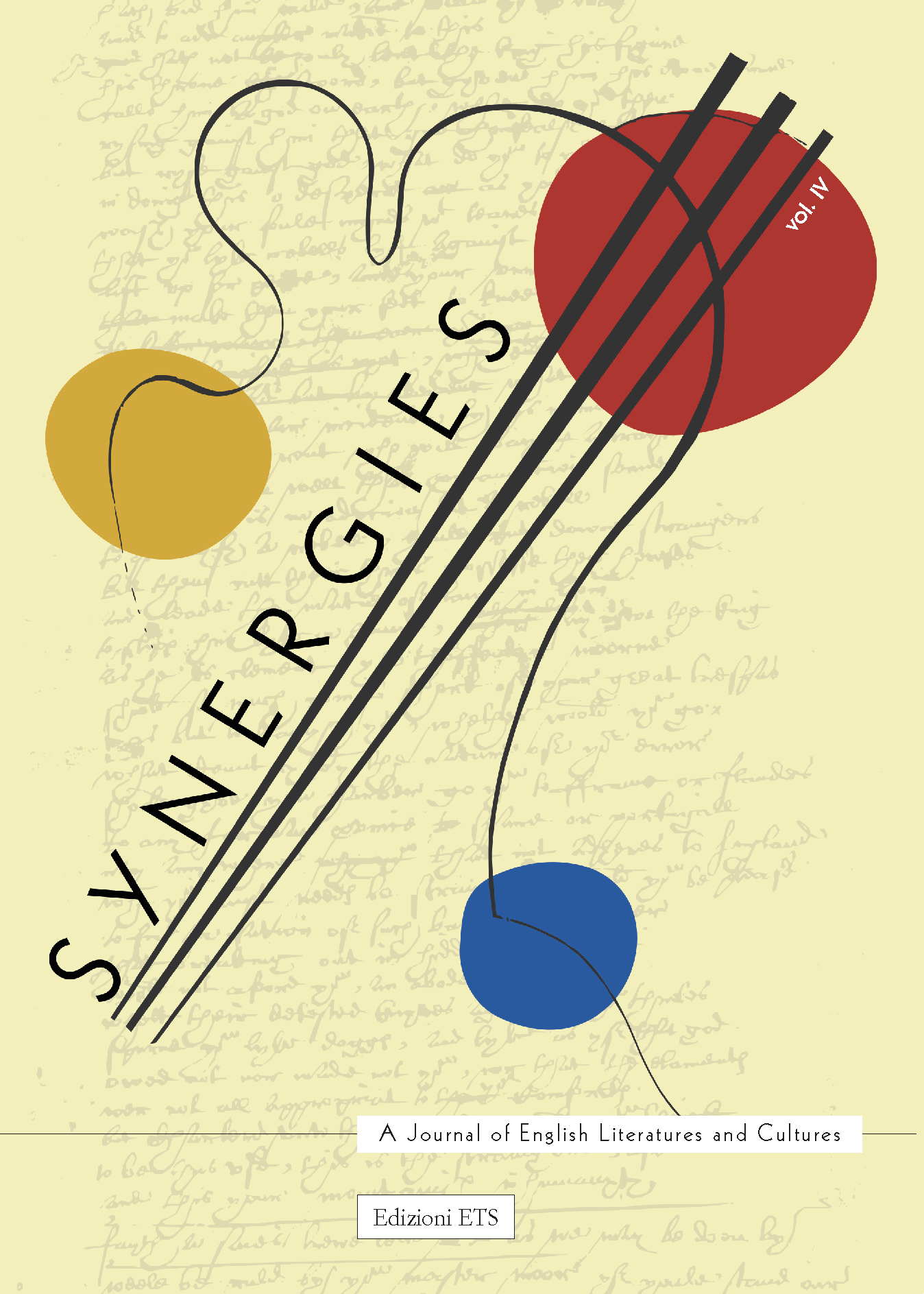“Se solo Wilde fosse vivo per vederti”: la lunga ombra di Oscar Wilde sull’opera di James Joyce
DOI:
https://doi.org/10.4454/syn.v4.905Parole chiave:
Oscar Wilde, James Joyce, Exile, Art, IrelandAbstract
: Il dialogo ideale instaurato da James Joyce con Oscar Wilde non è immediatamente palese, ma ci lascia spiazzati quando ne affiorano in superficie i ‘prestiti’ nascosti, a partire da “Telemaco”, il primo episodio dell’Ulisse. Come non restare interdetti nello scoprire che il famoso “specchio incrinato di una serva”, definito da Stephen Dedalus “un simbolo dell’arte irlandese”, non è farina del sacco di Joyce ma di Wilde? Joyce non attinse a Wilde solo per parlare delle sorti dell’arte irlandese, come nell’articolo che gli dedicò sul Piccolo della Sera di Trieste il 24 marzo 1909, ma anche per alludere nei suoi scritti al tema dell’omosessualità. In realtà, tutta l’opera di Joyce trabocca di debiti, riferimenti, allusioni e citazioni, più o meno esplicite, a testi di Wilde. Basterà solo accennare all’abitudine di Stephen Dedalus di parlare per aforismi ed epigrammi, per apologhi e parabole. La comune condizione di esuli/artisti dei due autori sarebbe una base sufficiente per leggere le loro opere e biografie in un’ottica parallela. Se, in “Telemachus”, Joyce fa proclamare a Buck Mulligan che “da Wilde e dai paradossi ci siamo emancipati”, in questo contributo si cercherà di mostrare quanto ciò non corrisponda al vero. Wilde non è presente solo in Ulisse, ma anche – e soprattutto – in Finnegans Wake, dove Joyce elabora il tema della ‘caduta’ e disegna il ‘ritratto’ finale di una lunga serie.
Riferimenti bibliografici
Atherton, James S., The Books at the Wake: A Study of Literary Allusions in James Joyce’s Finnegans Wake, London, Faber and Faber, 1959.
Backus, Margot Gayle, Scandal Work: James Joyce, the New Journalism, and the Home Rule Newspaper Wars, Notre Dame, IN, University of Notre Dame Press, 2013.
Beaufoy, Philip, “For Vera’s Sake”, Tit-Bits (London), 1 May 1897.
Beckett, Mary, Give Them Stones, London, Bloomsbury, 1987.
Corballis, Richard, “Wild Essence of Wilde: Joyce’s Debt to Oscar in Ulysses”, in Uwe Böker, Richard Corballis and Julie A. Hibbard (eds), The Importance of Reinventing Oscar: Versions of Wilde during the Last 100 Years, Amsterdam, Rodopi, 2002, pp. 159-66.
Eckley, Grace, “Why the Ghost of Oscar Wilde Manifests in Finnegans Wake”, Victorian Newsletter, 75, Spring 1989, pp. 9-14.
Ellmann, Richard, James Joyce, trad. it. Piero Bernardini, Milano, Feltrinelli, 1964.
Joyce, James, Dubliners, ed. Robert Scholes, London, Jonathan Cape, 1914.
—, Ulysses, ed. Hans Walter Gabler, London, Bodley Head, 1986.
—, A Portrait of the Artist as a Young Man, London, Penguin, 1992.
—, Finnegans Wake, London, Penguin, 1992.
—, Finnegans Wake, trad. it. Luigi Schenoni, Milano, Mondadori, 2001.
—, Lettere e saggi, a cura di Enrico Terrinoni, Milano, Il Saggiatore, 2016.
—, Ulisse, trad. it. Mario Biondi, Milano, La Nave di Teseo, 2020.
—, Ulisse, trad. it. Enrico Terrinoni, Milano, Bompiani, 2021.
Joyce, Stanislaus, My Brother’s Keeper, London, Faber & Faber, 1959.
Mahaffey, Vicki, “Père-version and Im-mère-sion: Idealized Corruption in A Portrait of the Artist as a Young Man and The Picture of Dorian Gray”, James Joyce Quarterly, 50 (1-2), 2012-2013, pp. 245-61.
Manganiello, Dominic, Joyce’s Politics, London, Routledge, 1980.
—, “Through a Cracked Looking Glass: The Picture of Dorian Gray and A Portrait of the Artist as a Young Man”, in Diana A. Ben-Merre and Maureen Murphy (eds), James Joyce and His Contemporaries, New York and Westport, CT, Greenwood Press, 1989, pp. 89-96.
Rabaté, Jean-Michel, James Joyce, Paris, Hachette, 1994.
Sammells, Neil, “Oscar Wilde, Quite Another Thing”, in Paul Hyland and Neil Sammells (eds), Irish Writing. Exile and Subversion, London and New York, Palgrave Macmillan, 1991, pp. 116-25.
Siedenbiedel, Catrin, “Oscar Wilde’s ‘Critic as Artist’ and the ‘Artist as Critic’ in James Joyce’s Finnegans Wake”, in Uwe Böker, Richard Corballis and Julie A. Hibbard (eds), The Importance of Reinventing Oscar: Versions of Wilde during the Last 100 Years, Amsterdam, Rodopi, 2002, pp. 167-73.
Terrinoni, Enrico, Su tutti i vivi e i morti. Joyce a Roma, Milano, Feltrinelli, 2022.
Walton, Franklin, “Wilde at the Wake”, James Joyce Quarterly, 14 (3), 1977, pp. 300-12.
West, Nathanael, Signorina Cuorinfranti, trad. it. Riccardo Duranti, Roma, E/O, 1988.
Wilde, Oscar, Doriano Gray dipinto, trad. it. Biagio Chiara, Napoli, Edizioni Bideri, 1906.
—, The Works of Oscar Wilde, ed. G.F. Maine, London, Collins, 1948 (in particolare: “The Sphinx Without a Secret: An Etching”, “The Nightingale and the Rose”, The Portrait of Mr W.H., “The Decay of Lying”, The Picture of Dorian Gray, The Soul of Man under Socialism, Salome, The Importance of Being Earnest).
—, Vera o i nichilisti, trad. it. Enrico Terrinoni, Milano, Feltrinelli, 2020.
—, Il ritratto di Dorian Gray, trad. it. e introduzione di Enrico Terrinoni, Milano, Mondadori, 2021.
Pubblicato
Fascicolo
Sezione
Licenza
I file contenuti nei fascicoli della rivista sono scaricabili solo su abbonamento entro 24 mesi dalla data di pubblicazione. Trascorso il periodo di embargo, i contenuti diventano ad accesso aperto e regolamentati dalla licenza generica Creative Commons versione 4.0 (cc. By 4.0). Il copyright dei singoli articoli va all’editore alla data di pubblicazione del contributo e torna agli autori e alle autrici una volta trascorso il periodo di embargo.
La rivista non richiede ad autori e autrici nessuna tariffa per la pubblicazione dei loro contributi.
Nel caso in cui l’autore/autrice voglia richiedere l’immediata pubblicazione in accesso aperto del proprio contributo, senza quindi attendere la data di scadenza del periodo di embargo, sarà tenuto/a a versare la cifra di 500,00 euro. Per avanzare questo tipo di richiesta è necessario rivolgersi al nostro ufficio di amministrazione (amministrazione@edizioniets.com) e alla responsabile delle riviste (journals@edizioniets.com) comunicando: titolo del contributo, estremi del fascicolo in cui esso è contenuto, dati della persona a cui intestare la fattura, presenza di eventuali finanziamenti di ricerca.


